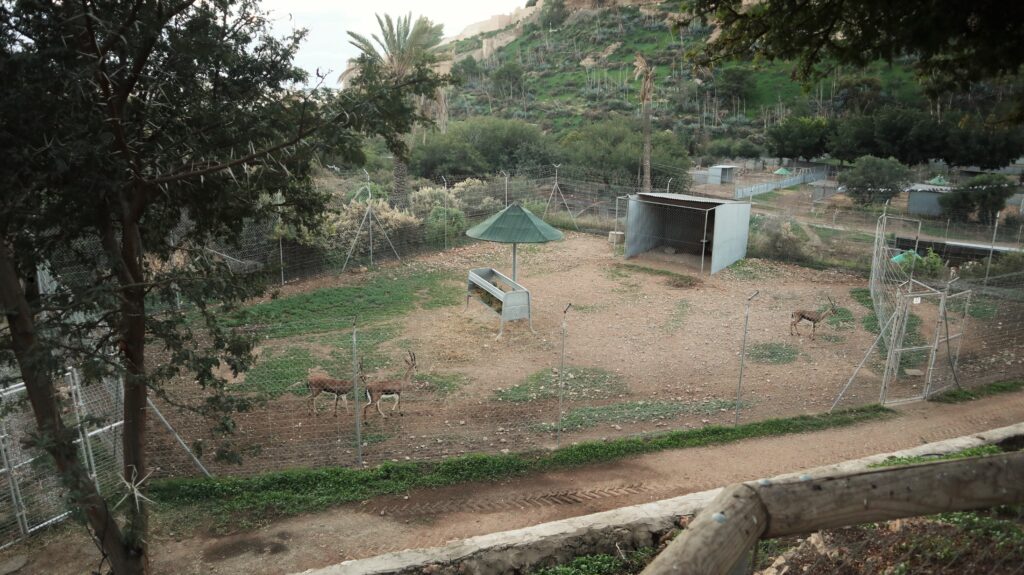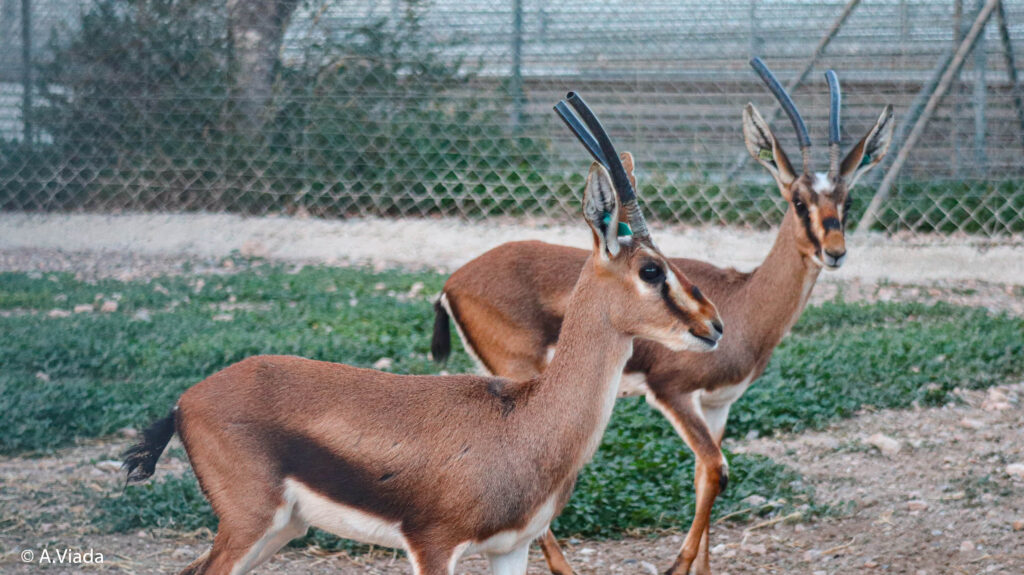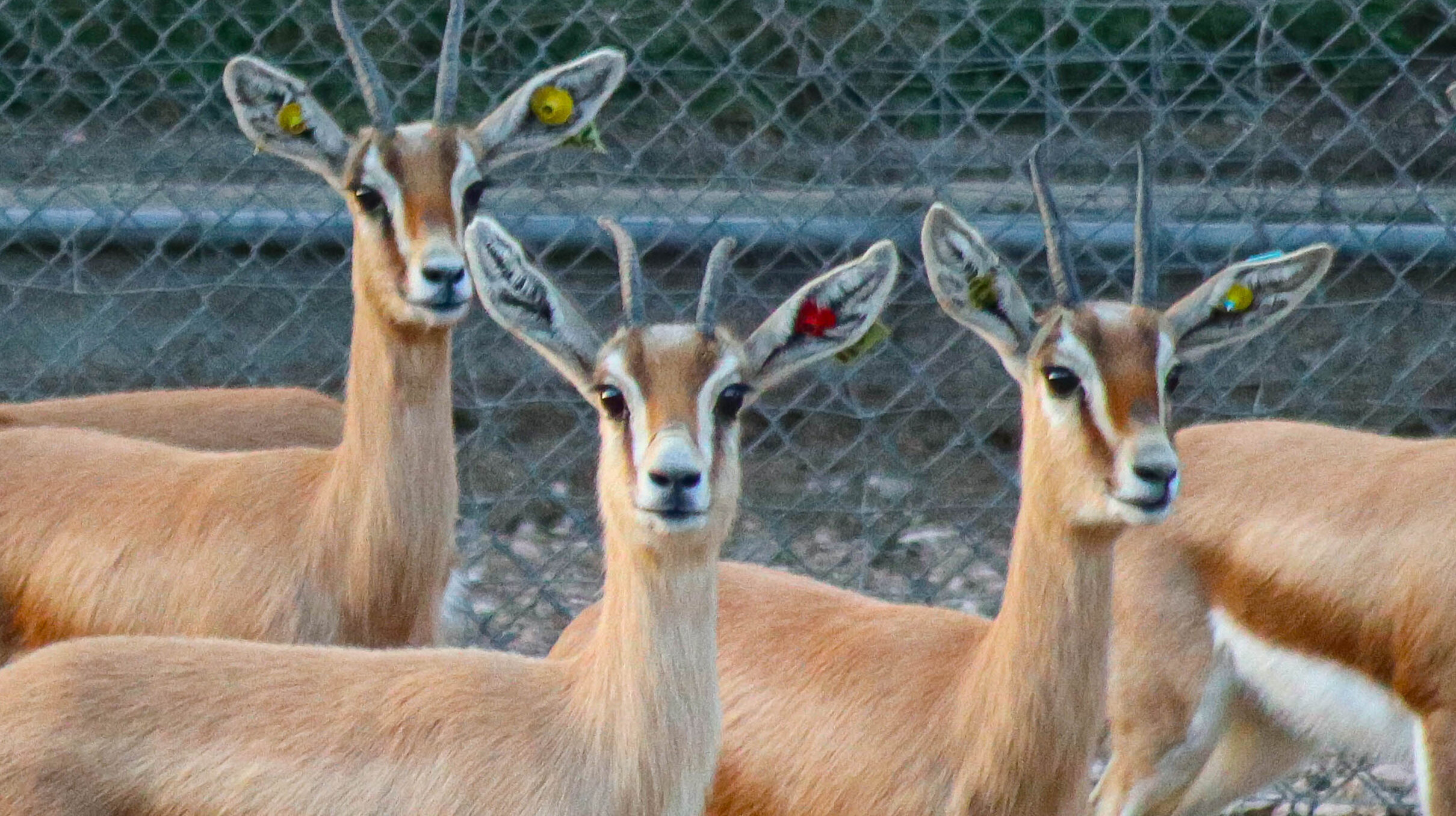Study site
This study was carried out at La Hoya Experimental Farm, which is part of the Spanish National Research Council’s Experimental Station of Arid Zones (EEZA-CSIC). This facility is located in Almería (Spain) and functions as both a research and breeding center for endangered African ungulates.
The enclosures in which the animals were kept varied slightly in size and shape, but all contained similar furnishing:
- Alfalfa and Concentrate feeders
- Umbrella for shade
- “Hut” (three walss and a ceiling) for shelter
- Salt lick rock
- Self-refilling water bowl.


Animals
A total of 63 gazelles (nine herds, three for each species) were observed. Individuals were differetiated by their ear tags, which corresponded to their studbook ID numbers by a colour code.



15 Cuvier’s gazelles
2 Experimental groups
1 Control group
24 Dorcas gazelles
2 Experimental groups
1 Control group
24 Dama gazelles
2 Experimental groups
1 Control group
Data Collection
Behavioural bservations were performed in 30-minute sessions for each herd, using an ad libitum sampling method for the behaviours detailed in the folowing ethogram:
| Behaviour | Type | Description |
|---|---|---|
| Feed Alfalfa | State | Gazelle manipulates, chews and ingests alfalfa (from feeders or off the ground). |
| Feed Concentrate | State | Gazelle takes the provided concentrate feed, using their snout to push the feeder door open, and proceeds to chew and ingest it. |
| Feed Browse | State | Gazelle manipulates, chews and ingests leaves, bark and other components of the provided fresh browse. |
| Feed Outside | State | Gazelle manipulates, chews, and ingests natural vegetation which grows outside the enclosure but is within their reach. |
| Drink | State | Gazelle drinks from the provided water bowl. |
| Forage | State | Gazelle stands or walks with its head low, sniffing or mouthing items on the ground and occasionally ingesting them. |
| Lick Rock | State | Gazelle licks the provided salt rock. |
| Lick Surface | State | Gazelle licks non-food objects, such as a wall or a fence. |
| Pacing | State | Gazelle continuously walks on a set, repetitive path. Usually alogn a wall (or part of it) of the enclosure. |
| Alarm | State | Gazelle is alert, looking at the direction of the source of the stimulus that caused the behaviour, performing specific vocalisations. This may be cooupled with stomping of one of the forelegs. |
| Sit | State | Gazelle is laying down and resting, with its head up looking around and/or ruminating, or completely resting on the ground, sleeping. |
| Stand | State | Gazelle is standing, performing no specific actions, may be ruminating. |
| Walk | State | Gazelle moves to a different location in the enclosure. |
| Agonistic approach | Event | Gazelle (A) points snout/horns, or headbutts towards a herd-mate (B). B may avoid A, ignore A, or respond with a similar behaviour. |
| Fight | State | Two or more gazelles fight headbutting each other, until one of them avoids the other(s), resulting in defeat. |
| Groom | State | Gazelle (A) grooms a heard-mate (B) by mouthing or licking a part of her body. |
| Rub Horns | State | Gazelle rubs her horns repeatedly in an up-and-down motion against a surface, such as a wall, fence, or log. |
Each group was observed once a week, and three groups were observed per day, all in the morning. In order to avoid variance related to time-of-day or day of the week, a rotating schedule was set.
The observer sat a few metres away from the enclosure and waited until the animals were habituated to their presence before starting the observation.
If a considerable area of the enclosure was not visible from a single viewing point, a Victure AC940 Action Camera was used, mounted on the fence, and the video was reviewed later using the same observation method and ethogram.
Experiment
The experiment was originally designed to consist of two nine-week periods: baseline (normal diet) and experimental (added browse). However, three weeks into baseline behaviour data colection, there was a change in diet for all animals in the facility due to a management shift and veterinary decision based on welfare.
The final arrangement is shown in the timeline below:

| BASE 1 | BASE 2 | CONTROL | EXPERIMENTAL |
| Fresh/dry alfalfa on an alternating day shcedule Concentrate feed ad libitum | Fresh+dry alfalfa ad libitum Concentrate feed ad libitum | Kept basic diet (same as Base 2) | Kept basic diet (same as Base 2) Added fresh browse once a week |
During the baseline period all herds had virtually the same conditions and data from all nine groups was pooled together.
During the experimental period, two herds of each species were given fresh browse once a week (on the day of observation) in the form of Acacia branches, Ficus branches, or palm fronds. The leftovers (naked branches) were removed from the enclosure after a few days.
Statistics
Once we had all our raw data, we averaged the percentage of time time (per 30-minute session) and frequency of all behaviours for each individual on each diet treatment – a total of three datapoints per individual for each behaviour.
Data analysis was done using JMP ® 8.0.2 for Mac. Variables that did not follow normal distribution were transformed and parametric tests (standard least square models) were then used. Multifactorial analyses were simplified into one-factor analyses when only one of the effects was significant (non-significant factors were removed).